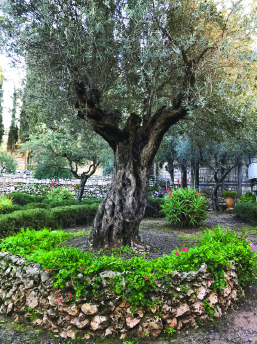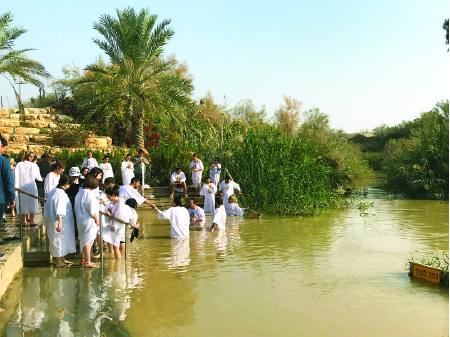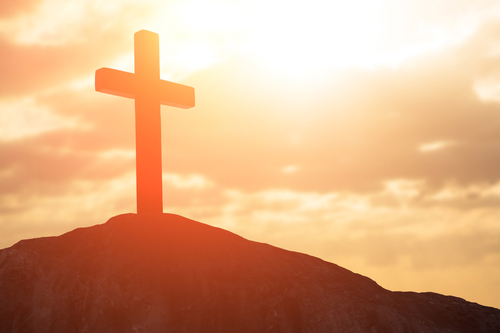In times of crisis, this heady Christian doctrine can become deeply personal—and reassuring.
By Eric Reed

The empty tomb. Pastor Jon McDonald of First Baptist Church of Casey led a tour of Israel in January. His wife, Lindsay, is a gifted professional photographer. She shared from her album some scenes that serve to illustrate this article.
Prologue
May I tell you a secret? When I close my eyes, I still see my wife on her deathbed.
Please stay with me. This article gets much more upbeat soon, but I have to start at this point so you will know why resurrection is so important to me right now. And it’s not because I want to get a jump start on the Easter celebrations. My need to understand resurrection has become very personal.
It’s been five months since my wife died. We spent her last three weeks in Room 101 at the hospice here in town. When I close my eyes, I sometimes—make that often—see her laying on the hospital bed in silhouette against the window. Each day as the sun passed over the building toward her west-facing window, the outside light would become quite bright. And I, sitting on the opposite side of the bed in a vinyl chair, would stare at her, and beyond her into sunlight.
I can muster other scenes from those weeks: Her sister sitting on the sofa under the window texting relatives. Our dog coming for a visit. Friends praying and doing their best to cheer us. One couple bringing a guitar and my wife singing hymns from memory, even third verses, when she was unable to say much else.
And I can see the night when I played Gaither songs on YouTube, and during “We Shall Behold Him,” my wife lifted both arms upward and pointed. “What do you see?” I asked. “A glimpse of heaven? Your mother?” Eyes closed, she nodded. She was eager to see her mother and old friends from the church where she grew up.
Then she lowered her arms and clasped her hands together. “Do you want me to pray?”
She nodded.
I prayed kind of like Jesus prayed on the cross at the very end, commending her spirit to the Father.
From that time, she hardly moved. I sat there for most of two days waiting for her body to catch up with her soul, staring across her prone figure into the light.
That’s the image I see.
That’s why resurrection has become not just a doctrine, but an urgency to me. The Resurrection of Jesus? Certainly. What is our faith without it? But also my wife’s resurrection, and my own. Whole libraries have been written on the Resurrection of Jesus, but relatively little on the resurrection of believers, and even less about resurrection as a necessary present-time action.
For me this year, Easter is not just a happy dance outside an empty grave, but a time of seeking earnestly the assurance of things to come, the affirmation of reunion, and a down payment on glory. In the meantime, resurrection—not as a future event, but here and now—becomes enough to get us through the here and now.
If you’ve wondered whether you can make it through today, much less tomorrow, then join me as we think about resurrection.

Gethsemane
One word changes everything
Weeping outside her brother’s tomb, Martha insisted that if Jesus had hurried on, Lazarus would still be alive. His first words to her were cold comfort. Her response to the promise that Lazarus would rise again seems to be more a protest than an affirmation. “I know that he will rise again in the resurrection on the last day,” she said. But she was more concerned about the present day.
Jesus’ reply turns her to the truth standing before her: “I am the resurrection and the life. Whoever believes in me, though he dies, yet shall he live, and everyone who believes in me shall never die. Do you believe this?”
If the religious leaders standing there in the cemetery heard Martha’s statement, some would have applauded, others would have shaken their heads. The Pharisees believed the righteous dead would be raised at the end, while the Sadducees argued there was no resurrection at all.
Martha’s reply hinges not on the teachings of the major schools of Jewish thought, but on the words that Jesus has just applied to himself. He is life (zoe in Greek), and he is the very thing that guarantees life.
A friend of mine phoned across the country to tell his parents their grandchild had been born, a beautiful baby they called Anastasia. The proud dad heard his own father, a seminary professor, laughing from a thousand miles away.
“Well, son,” the older man said, “that little girl will always stand up to you. And no one will ever back her down.” He chuckled some more. “You named her anastasis, the Greek word meaning to stand up again.”
When Jesus called on Lazarus to come out of the tomb, Martha and Mary and the crowd around them saw anastasis in action. Lazarus stood up again.
More important, that’s what Jesus did soon after at his own Resurrection—stand up again. It’s a simple phrasing for a complex event: anastasis describes plainly the pivotal point in history, for, as one observer said, without the Resurrection of Jesus, Christianity is quite literally dead.
The Father calls, Arise! and Jesus stands up. The One who lay down his life for our sake takes it up again and emerges from the place of death into life everlasting. As he does, Jesus proves to the world that he is the Christ.
Resurrection is proof that Jesus is alive. So much for claims that robbers stole his body: The grave was sealed and guarded. So much for the swoon theory: Jesus didn’t pass out, he died. The soldier’s gash in Jesus’ side proved it, as water separated from blood gushed out. And if more proof were needed, the grave clothes were still in the grave, and the head cloth was neatly wrapped and laid aside by one who sat up, stood up, and no longer needed it. So much for mouldering in the grave: He is not here, he is risen!
Jesus’ declaration that he is the resurrection was proven on Resurrection morning. But the question of what that means in our hour of need remains.
A down payment on our future
Baptists are not a creedal people, so not many of our churches recite the Apostles’ Creed on a regular basis. Yet, we find in those summaries of the Christian faith a statement that the early church fathers felt was crucial to their belief in Jesus: “I believe in…the resurrection of the body…” Likewise, the Nicene Creed lists “resurrection of the dead.”
From the fourth century onward, believers needed to state aloud, along with their systematic beliefs about the Father, Son, and Holy Spirit, their own hope for themselves. This was true in a largely illiterate culture, so leaders built the statements into the worship services. This was a necessary response to various movements in the early centuries of the church that denied or misconstrued the deity of Jesus, and belittled the future hopes of his followers.
“Jesus was raised from the dead, and we will be too!” If the worship service had been a pep rally, that would have been the cheer, starting in 325 A.D.
This simple statement affirming the resurrection is based on verses in the Gospels and Epistles, of which Paul’s masterwork is 1 Corinthians 15. What the apostle says briefly in Romans 6:5—“For if we have been united with him in a death like his, we shall certainly be united with him in a resurrection like his”—is unpacked in 58 verses to the Corinth church.
You can’t blame the Christians in Corinth for sounding a little selfish. “We believe in Jesus,” they might have said, “but what’s going to happen to us?”
Paul reminds them that his teaching about Jesus is of “first importance”—“that Christ died for our sins in accordance with the Scriptures, that he was buried, that he was raised on the third day…” (1 Cor. 15:3-4). Whatever they may understand about their own coming resurrection is based on Jesus’ resurrection. Paul calls him the “first fruits” of the believers, in the same way that the first grains of the harvest forecast much more to come. (Around here, we would be more likely to talk about the first ripe tomato of summer or the first ear of corn.) There is such joy when the first fruits come in, because it’s only the beginning of harvest season and celebration.
Paul continues the agricultural imagery.
“‘How are the dead raised? With what kind of body do they come?’….What you sow does not come to life unless it dies. And what you sow is not the body that is to be, but a bare kernel, perhaps of wheat or of some other grain. But God gives it a body as he has chosen, and to each kind of seed its own body….So is it with the resurrection of the dead. What is sown is perishable; what is raised is imperishable. It is sown in dishonor; it is raised in glory. It is sown in weakness; it is raised in power” (vv. 35-38, 42-43).
“The analogy of the seed enables Paul to walk a fine line,” scholar Richard Hays wrote, “asserting both the radical transformation of the body in its resurrected state and yet its organic continuity with the mortal body that precedes it.”
That should be good news to us.

Sea of Galilee
Will I know my mother?
In her final week, I asked my wife again if she was scared. Of death itself? “No,” she responded, “but dying is coming quicker than I expected, and dying isn’t so easy.” She knew that her faith in Jesus as Savior would see her through to heaven, “but,” she said, “will I know my mother?”
I was surprised by that question. I thought she knew that for certain, but now she needed reassurance. I rifled through my pastoral answers: Paul says, “For now we see through a glass, darkly; but then face to face: now I know in part; but then shall I know even as also I am known” (1 Cor. 13:12 KJV).
- Mary recognized Jesus after his Resurrection when he spoke to her. The pair walking on the road to Emmaus recognized Jesus. He was somehow changed, but he was still Jesus.
- Thomas saw Jesus a week after his first appearance to the disciples. Meeting them a second time in the upper room, the scars showed that his glorified body was still his body. In some way it was still his earthly body—changed, transformed, glorified, but still his.
- From his boat, Peter saw Jesus at a distance barbequing a beachside breakfast. Realizing who it was, Peter jumped into the water to swim to him, and left the others to row the boat in.
In these scenes from Easter morning forward, we see that resurrection—his and ours—proves God cares about the person and our personhood. He’s not just keeping the ethereal, spirit-y part of us, but he promises the preservation of all that makes us us. The questions that come up about the deceased whose bodies are destroyed or lost or cremated are rendered irrelevant by these truths: We are all made of dust and to dust we will return, but God has promised to this dust that it will stand again. In the biblical examples we have, the person was known by those who saw him. Organic continuity.
My wife wanted to hear that. “Will I know my mother in heaven?” was a way of saying, Will Mom still be Mom? Will I still be me?
Frankly, it was a word I needed too. I needed assurance that at the resurrection of the dead, a body ravaged by cancer is somehow transformed into something immortal and incorruptible and glorious. God promises to raise us from the dead, preserves yet transforms us, and that action assures us we will be together again.
When and how, we don’t know for sure, but we’re sure it’s coming. And like my wife said, it seems to be coming more quickly than I expected.
“For the Lord himself will descend from heaven with a cry of command, with the voice of an archangel, and with the sound of the trumpet of God. And the dead in Christ will rise first. Then we who are alive, who are left, will be caught up together with them in the clouds to meet the Lord in the air, and so we will always be with the Lord” (1 Thessalonians 4:16-17).
As if there was any doubt. “I will arise and go to Jesus; he will embrace me in his arms,” the hymnwriter said. Or as Paul concluded his Thessalonian note: “Therefore encourage one another with these words.”
The Resurrection of Jesus foretells the resurrection of his followers. For me in recent months, that has proven to be a powerful, bankable promise from God. (See Philippians 3:10-11.) But what about the meantime? What does resurrection mean to us right now?

The River Jordan
Throw some wood on the fire
Let’s be careful that this article doesn’t take a sharp, unwarranted turn at this point. That said, here is a road we should go down, if only briefly.
With Christ’s resurrection on one end of the timeline, and the promise of our own on the other end, what’s in the middle? I find an answer in that word we most often translate as resurrection: anastasis.
Literally the word means “stand up!” While linked theologically to life after death in many New Testament uses, it’s also a simple command to those who are sitting, resting, or, perhaps, lollygagging.
- When Jesus called Matthew to be his disciple, the tax collector “arose” and followed him (Matthew 9:9).
- Jesus told Jairus’s little girl to get up from her deathbed and she “arose” (Mark 5:42).
- Jesus said the prodigal son came to his senses and “arose” to go to his father (Luke 15:18, 20).
- Jesus told the one healed leper who returned to give thanks to “arise” and go his way (Luke 17:19).
- The Holy Spirit told Philip to “arise” and head south for his divine appointment to share the gospel with the Ethiopian eunuch (Acts 8:26).
- And on the road to Damascus, Jesus commanded Paul to “arise” and go into the city for further instructions (Acts 9:6).
For those mired in grief, daydreaming about what might be, or lamenting what never was, this imperative is a big help. Stand up. In other words, until that final morning when we all stand up, there’s a lot of daily getting up to do and serving to fulfill Jesus’ mission.
There’s a lot of work to be done.
I’m still thinking about a story Pastor Ralph Schultz of Fieldon Baptist Church told at the Sandy Creek Association’s fall meeting. When he was a teenager, his family home was heated by a wood stove. Just before bedtime, his father would stoke the fire to keep the house warm overnight. Ralph would be snug in his bed and sleep soundly for several hours, but as morning approached, he would discover he was awake and thinking, “Someone needs to throw some wood on the fire.”
In a few minutes, Ralph’s father would call out from his own bedroom, “Son, get up and throw a log on the fire!”
“The house was cold, we needed someone to throw some wood on the fire,” Ralph said, “and I realized that ‘someone’ was me.”
Anastasis.
Epilogue
Maundy Thursday will mark six months since my wife died. On that day before Good Friday, I will retire some of my small grief rituals. Soon afterward, the dog and I will move to a new house in hopes of creating some fresh memories. And on Resurrection Sunday, I will arise and run with the disciples to the empty tomb, then beyond, seeking the Risen Savior.
“He is not here, he is risen,” I will hear.
And one day, by God’s grace, we will be risen too.
Eric Reed is editor of Illinois Baptist media and IBSA’s associate executive director for Church Communications.

















 Coptic Christians pray, persevere after Egypt church bombings
Coptic Christians pray, persevere after Egypt church bombings